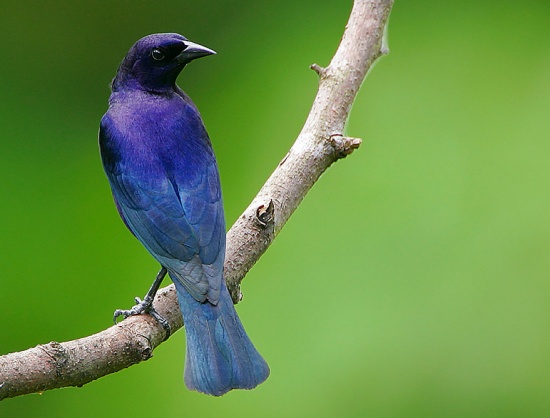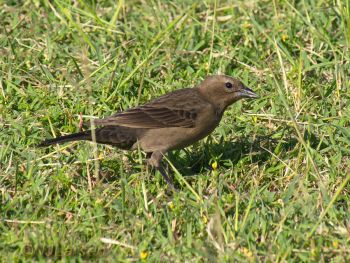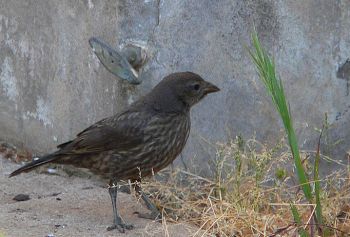- Molothrus bonariensis
Identification
Male: Shiny black with purple gloss, conical bill (See note under picture)
Female: Grayish brown upperside, lighter brown underside with slight spotting, faint supercilium
Eyes dark brown.
Similar Species
Carib Grackle differs in having pale eye, longer bill, and keel-shaped tail, where tail of Shiny Cowbird is flat
Scrub Blackbird is larger with a longer, thinner, less conical bill and longer legs. It has a much shorter primary projection which barely extends on to the rump. Its plumage usually appears slightly duller than Shiny Cowbird
Distribution
Found from south east USA through the Caribbean and South America to Argentina. The spread north from South America through the Caribbean started around 1900 and is still ongoing.
Strangely, the species initially did not become established in or completely circumvented some of the islands in the Lesser Antilles including e.g., Dominica, where it only started to appear in numbers around 2011-2012.
Taxonomy
Subspecies
There are 7 subspecies[1]:
- M. b. minimus
L Antilles (n to Martinique), Trinidad, Tobago, Guianas, n Brazil
- M. b. cabanisii
Eastern Panama (Darien) to Colombia
- M. b. venezuelensis
Tropical eastern Colombia and northern Venezuela
- M. b. aequatorialis
Tropical southwestern Colombia to westrn Ecuador and Isla Puna
- M. b. occidentalis
Extreme southwestern Ecuador (Loja) and w Peru (south to Lima)
- M. b. riparius
Tropical eastern Peru (Río Ucayali) to lower Amazon Valley (Para)
- M. b. bonariensis
Eastern Bolivia to Paraguay, Brazil, Uruguay and central Argentina
Habitat
Favours open areas with some scrub or trees, including agricultural areas and gardens. Favors lower elevations in the Caribbean but also found in higher elevation in the Andes.
Behaviour
Breeding
This species engages in nest parasitism where the female lays its eggs in the nest of other birds, with 250 different species known to have had eggs placed in their nest and almost 100 of these known to have raised young of Shiny Cowbird. In the Caribbean, there seems to be a preference for members of the icterids such as orioles and blackbirds, but in southern South America many different groups of birds are among the known hosts. Shiny Cowbird has caused a decline in several species, and is one of the reasons that the Yellow-shouldered Blackbird is endangered. During egg laying, it is common that Shiny Cowbird puncture or remove at least one host-species egg from the nest.
References
- Clements, J. F., T. S. Schulenberg, M. J. Iliff, S. M. Billerman, T. A. Fredericks, B. L. Sullivan, and C. L. Wood. 2019. The eBird/Clements Checklist of Birds of the World: v2019. Downloaded from http://www.birds.cornell.edu/clementschecklist/download/
- Lowther, P. E. and W. Post (2020). Shiny Cowbird (Molothrus bonariensis), version 1.0. In Birds of the World (S. M. Billerman, Editor). Cornell Lab of Ornithology, Ithaca, NY, USA. https://doi.org/10.2173/bow.shicow.01
Recommended Citation
- BirdForum Opus contributors. (2025) Shiny Cowbird. In: BirdForum, the forum for wild birds and birding. Retrieved 25 April 2025 from https://www.birdforum.net/opus/Shiny_Cowbird
External Links
GSearch checked for 2020 platform.1






